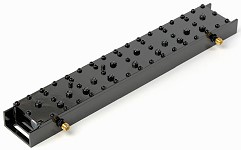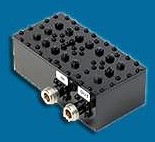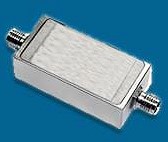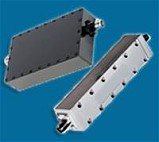Anatech Electronics May 2023 Newsletter |
||

Press Release Archives: 2024 | 2023 | 2022 | 2021 |2020 2019 | 2018 | 2017 | 2016 | 2015 2014 | 2013 | 2012 | 2011 | 2010 2009 | 2008 | 2007 | 2006 | 2005 Content is copyright of company represented. Page format, custom text and images are RF Cafe copyright - do not distribute.
Sam Benzacar of Anatech Electronics, an RF and microwave filter company, has published his May 2023 newsletter that features his short op−ed entitled "Z-Axis Positioning Finally Arrives," which discusses the FCC's "Wireless E911 Location Accuracy Requirements" mandate for providing altitude information from the point an emergency assistance call is placed. It says in part, "...requires nationwide wireless providers to deploy z-axis technology nationwide by April 3, 2025." It is not a trivial requirement since cell tower triangulation and even embedded GPS sensors cannot provide altitude (z-axis) position precisely enough to pinpoint floor-level location. The FCC wants to know what floor of a building from which the call originates. Sam mentions NextNav's Pinnacle system that uses a precision barometric pressure sensor in the phone, tablet, computer, etc., to provide the altitude information. After reviewing available info on Pinnacle, I don't see how a pressure sensor can provide floor-level height without a very nearby reference pressure sensor at some fixed, known height to compare readings. Pinnacle must have a network of such sensors in urban areas, because a general barometric pressure reading for a wide area would not be sufficient. Ambient barometric pressure is constantly changing, so a highly accurate referenceless reading is practically useless. Pilots always calibrate their [non-GPS and non-radar] altimeters (barometers calibrated to read out in units of height) at a point on the airport where the altitude is known to some accuracy. Prior to landing, local barometric pressure information is obtained via radio in order to re-calibrate the altimeter. Poor visibility makes such calibration essential in order to know for sure how high above the ground and obstacles you are flying. The world's most accurate barometric altimeter is wasted without a local reference. A Word from Sam Benzacar - Z-Axis Positioning Finally Arrives
The 911 system has been invaluable since it was first deployed in 1968 and we consider it infallible. However, a lingering problem has been the ability to identify the location of the call when it's made from a mobile device. This isn't the case with a wired landline because the phone is associated with an exact address. However, the number of households with landlines has declined to about 30% last year and more than 70% only have smartphones. As result, more than 80% of 911 calls are made from these devices, which presents a problem because cell site triangulation yields only the location of the nearest cell site not the exact location of the caller. And while triangulation is increasingly complemented with GPS, satellite signals are too weak to penetrate buildings or other structures. The most vexing challenge has been determining the vertical dimension or floor level because location information provided by smartphones is limited to the x and y coordinates -- latitude and longitude-- not the vertical (z) dimension. So, if you place a 911 call from inside a multi-story apartment building, for example, you could be on any floor and in any apartment. Researchers have been working to solve this problem for years and the FCC ruled that wireless carriers must provide the "floor-level" indoor location of a 911 caller. This was supposed to be implemented by April 2021 in the top 25 major U.S markets and in the Top 50 markets by April of this year with a vertical accuracy of ±3 m for 80% of calls. The question is why it has taken so long to solve this problem when a company called NextNav in Tysons, VA, has had a Z-axis solution for years. Their technology uses the barometric pressure sensors that are present in every phone. Changes in atmospheric pressure can be used to estimate the relative height or floor level of a caller within a building with a high level of precision. NextNav's metropolitan beacon system (now called Pinnacle) produces results equal to better than those required by the FCC in both its own tests and those conducted various agencies. With few other choices, wireless carriers have finally selected the company as the z-axis solution and it's available on an increasing number of smartphones. AT&T has also adopted it for use in its FirstNet nationwide, broadband wireless network for law enforcement, firefighters, and public safety officials. Fixed Wireless Access Broadband on a Roll
Bending the Waves
6G Begins to Take Shape
Antares Vision Group and Wavision, a start-up from the Polytechnic University of Turin, Italy, is using microwave technology to detect foreign bodies in packaged products. The system uses sensors that Wavision developed for inspection machines that could replace X-rays and metal detectors. Microwave emissions can determine whether foreign bodies are present in creams, semi-liquids, and liquids, and the machine can see plastic, glass, wood, bones, rubber, insects, and all metals. The process is essentially anomaly detection based on dielectric contrast and monitoring the variation of the electric field imposed by the sensing system caused by the presence of a foreign body. Anatech Electronics Introduces a New Line of Suspended Stripline and Waveguide Type RF Filters
Check out Our Filter Products
Cavity Band Pass Filters LC Band Pass Filters Cavity Bandstop/Notch Filter About Anatech Electronics Anatech Electronics, Inc. (AEI) specializes in the design and manufacture of standard and custom RF and microwave filters and other passive components and subsystems employed in commercial, industrial, and aerospace and applications. Products are available from an operating frequency range of 10 kHz to 30 GHz and include cavity, ceramic, crystal, LC, and surface acoustic wave (SAW), as well as power combiners/dividers, duplexers and diplexers, directional couplers, terminations, attenuators, circulators, EMI filters, and lightning arrestors. The company's custom products and capabilities are available at www.anatechelectronics.com. Contact: Anatech Electronics, Inc.
Posted May 24, 2023 |
||

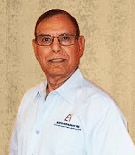 By Sam Benzacar
By Sam Benzacar T-Mobile and Verizon now have more
than 4 million customers using the companies' fixed wireless access (FWA) platforms
for residential broadband, according to a report from research firm MoffettNathanson
using data provided by Opensignal. In addition, in Leichtman Research Group's latest
quarterly assessment of the U.S. home broadband market the two wireless companies
added 916,000 FWA customers in the first quarter of this year. Growth in FWA subscribers
is also growing internationally and more than 75% of service providers in more than
100 countries are offering it as well, according to Ericsson. The company also predicts
that 5G-based FWA connections will reach 235 million by 2028.
T-Mobile and Verizon now have more
than 4 million customers using the companies' fixed wireless access (FWA) platforms
for residential broadband, according to a report from research firm MoffettNathanson
using data provided by Opensignal. In addition, in Leichtman Research Group's latest
quarterly assessment of the U.S. home broadband market the two wireless companies
added 916,000 FWA customers in the first quarter of this year. Growth in FWA subscribers
is also growing internationally and more than 75% of service providers in more than
100 countries are offering it as well, according to Ericsson. The company also predicts
that 5G-based FWA connections will reach 235 million by 2028.  NTT DOCOMO has tested what it believes
to be world's first trial of redirecting 28 GHz signals from inside a building to
the foot of the building outdoors by "bending" the waves. It uses a film-shaped
transmissive metasurface attached to a window designed to send millimeter-wave signals
passing through a glass window in a specific direction. The film-shaped material
was attached to the window glass on the interior side, making it easier to install
and its transparency did not spoil the landscape and existing design. The transmissive
metasurface is also designed not to affect other frequency bands.
NTT DOCOMO has tested what it believes
to be world's first trial of redirecting 28 GHz signals from inside a building to
the foot of the building outdoors by "bending" the waves. It uses a film-shaped
transmissive metasurface attached to a window designed to send millimeter-wave signals
passing through a glass window in a specific direction. The film-shaped material
was attached to the window glass on the interior side, making it easier to install
and its transparency did not spoil the landscape and existing design. The transmissive
metasurface is also designed not to affect other frequency bands.  The European Telecommunications Standards Institute
(ETSI) now has an Industry Specification Group (ISG) to undertake preliminary work
on the use of terahertz frequencies in 6G communications. According to ETSI, the
ISG THz has 31 participating companies and is determining what the priorities should
be for using terahertz frequencies for 6G, which is supposed to be coming around
the end of the decade. The focus is no high-data-rate mobile applications such as
virtual or augmented reality and applications requiring both communication and sensing
capabilities, such as holographic telepresence and interactive robotics.
The European Telecommunications Standards Institute
(ETSI) now has an Industry Specification Group (ISG) to undertake preliminary work
on the use of terahertz frequencies in 6G communications. According to ETSI, the
ISG THz has 31 participating companies and is determining what the priorities should
be for using terahertz frequencies for 6G, which is supposed to be coming around
the end of the decade. The focus is no high-data-rate mobile applications such as
virtual or augmented reality and applications requiring both communication and sensing
capabilities, such as holographic telepresence and interactive robotics.  Microwave Energy Aids Substance Detection
Microwave Energy Aids Substance Detection 